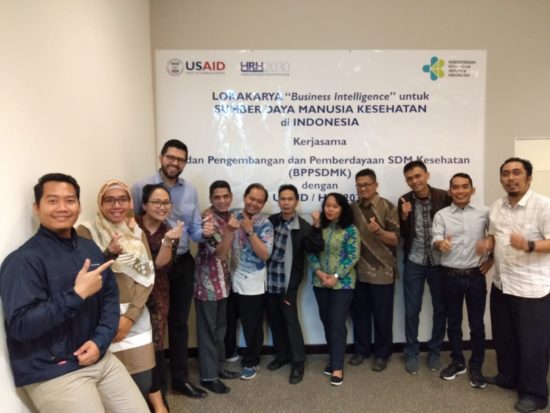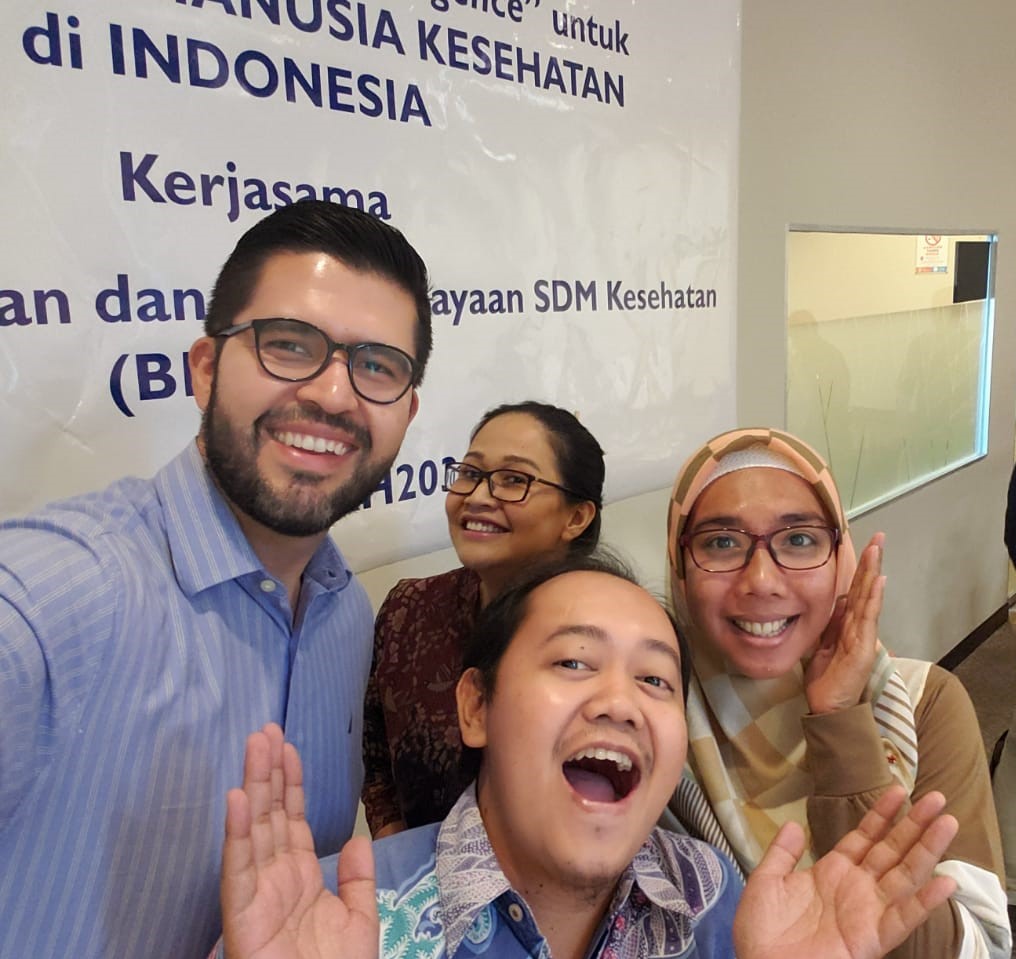
18 Nov Strengthening Data Use by Empowering the Team: HRH2030 in Indonesia
 Stuardo Herrera (seen at left in photo at right) is the informatics technical advisor at Palladium, an HRH2030 program partner. He traveled to Indonesia earlier this year to help facilitate a workshop for the Ministry of Health on data visualization and dashboard development.
Stuardo Herrera (seen at left in photo at right) is the informatics technical advisor at Palladium, an HRH2030 program partner. He traveled to Indonesia earlier this year to help facilitate a workshop for the Ministry of Health on data visualization and dashboard development.
We’ve all seen health initiatives around the world focused on collecting massive amounts of data from different sources using a variety of technologies. But how often do we hear that they are strengthening what I consider the most essential component of any information system implementation, that is, the human resources—the people—who actually do this work?
It doesn’t matter how much data we have on human resources for health (HRH), if we don’t use the data to inform decision-making. And without using the data, we won’t achieve the sustainable impact that we want. It’s essential to have reliable, up-to-date, complete, and quality health workforce data for planning and decision-making at the country level. The data produced by information systems should be used for more than just outputs. It should be used to take action.
If there is something Indonesia doesn’t lack, it is data richness. According to the HRH2030 HRIS Status Review completed last February, there are more than 10 government agencies that collect data on health workers. Imagine if all this data could be integrated into a single source of information building a complete picture of the health workforce in the country! The ability to plan for the continuous development of an adequate health workforce would expand, ensuring that population health needs are met through access to the appropriate HRH skills mix and distribution.
Indonesia’s Ministry of Health has clearly envisioned this scenario and is working towards that goal. With technical assistance from HRH2030, they are building a data analysis platform that will integrate information from multiple sources—internal and external—for the Ministry of Health, to track information that spans the lifecycle of the health worker. To implement this strategy, they have started by strengthening their team. As Ms. Shinta Dewi, the Human Resources Information System (SI-SDMK) team lead told me, “The system (and its data) will be as strong as the team supporting it.”
To support this vision, I went to Indonesia in June to help facilitate a Data Visualization and Dashboard Development workshop for the Ministry of Health Board of Human Resources for Health Empowerment and Development. This unit is in charge of the SI-SDMK, including the data analysis platform. It is crucial for this team to not only to have data, but to also have the necessary skills to present it in ways that are easy to understand and easy to use for decision-makers in the Ministry of Health.
During the first part of the workshop, we did several activities to understand best practices and guidelines to develop data visualizations using user-centered design as the guiding principle. The team was excited for these exercises, because they are usually focused on processing data and not so much on thinking about how stakeholders will use the data. In talking with Mr. Timor Utama, data analyst for SI-SDMK, for example, I learned that he had many ideas to develop data visualizations to help decision-makers address gaps in service demands and thus improve health outcomes.
In the second part of the training, participants learned the data analysis tool, Tableau, through a learning-by-doing methodology, using data from SI-SDMK. They formed teams to plan and produce dashboards rich with data that would answer questions that they know health sector stakeholders are asking. One of the main objectives of this exercise was to strengthen collaboration between key HRH stakeholders. The strategy was useful because participants included staff from the Center for Workforce Policy and Planning (PUSRENGUN), and the Sub-Division for Data and Information, two units that collaborate to produce workforce information. In our final discussion, Ms. Riza Sofia, an official from PUSRENGUN, expressed to the group that she was looking forward to ways in which they could share data and develop dashboards collaboratively in the future to address the planning and demand information needs of the Ministry of Health.
The future of the Human Resources Information System and data analysis platform now resides in the technical team. They are empowered to produce data visualizations and dashboards that will help translate data into action for decision-makers that, as a result, will shape the future of health in Indonesia.
___
Photo: Stuardo Herrera (fourth from left) with staff from the Indonesia Ministry of Health Board of Human Resources for Health Empowerment and Development. Credit: Stuardo Herrera, 2019.





